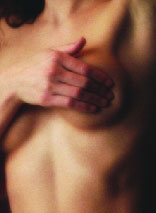Breast self-examination
Breast Self-Examination
Breast self-examination (BSE) is a method by which individuals can check their own breasts for breast cancer or other abnormalities. It is a simple procedure that can be performed at home and is intended to help individuals become familiar with the normal state of their breasts, so that they can detect any changes early.
Purpose
The primary purpose of breast self-examination is to increase awareness of the normal condition of one's breasts and to detect any unusual changes as early as possible. While BSE is not a substitute for professional medical screening, such as mammography, it can be a useful tool for early detection of breast abnormalities.
Procedure
Breast self-examination involves a few simple steps that can be performed in front of a mirror, in the shower, or lying down. The examination typically includes visual inspection and manual palpation.
Visual Inspection
1. Stand in front of a mirror with shoulders straight and arms on hips. 2. Look for any changes in the shape, size, or symmetry of the breasts. 3. Check for any visible distortion or swelling. 4. Raise arms and look for the same changes. 5. Look for any signs of fluid coming out of one or both nipples.
Manual Palpation
1. Lie down and use the right hand to feel the left breast and vice versa. 2. Use a firm, smooth touch with the first few fingers of the hand, keeping the fingers flat and together. 3. Cover the entire breast from top to bottom, side to side. 4. Follow a pattern to ensure that the entire breast is covered, such as circular, vertical, or wedge patterns. 5. Feel for any lumps, thickening, or hardened knots.
Importance of Regular Examination
Regular breast self-examinations can help individuals become familiar with the normal look and feel of their breasts. This familiarity can make it easier to notice any changes, such as lumps or thickenings, which should be reported to a healthcare professional promptly.
Limitations
While breast self-examination can be a useful tool for early detection, it is not a replacement for regular screening by a healthcare professional. BSE does not detect all breast cancers, and not all detected lumps are cancerous. Therefore, it is important to combine BSE with other screening methods, such as clinical breast exams and mammograms.
Related Pages
Transform your life with W8MD's budget GLP-1 injections from $125.
W8MD offers a medical weight loss program to lose weight in Philadelphia. Our physician-supervised medical weight loss provides:
- Most insurances accepted or discounted self-pay rates. We will obtain insurance prior authorizations if needed.
- Generic GLP1 weight loss injections from $125 for the starting dose.
- Also offer prescription weight loss medications including Phentermine, Qsymia, Diethylpropion, Contrave etc.
NYC weight loss doctor appointments
Start your NYC weight loss journey today at our NYC medical weight loss and Philadelphia medical weight loss clinics.
- Call 718-946-5500 to lose weight in NYC or for medical weight loss in Philadelphia 215-676-2334.
- Tags:NYC medical weight loss, Philadelphia lose weight Zepbound NYC, Budget GLP1 weight loss injections, Wegovy Philadelphia, Wegovy NYC, Philadelphia medical weight loss, Brookly weight loss and Wegovy NYC
|
WikiMD's Wellness Encyclopedia |
| Let Food Be Thy Medicine Medicine Thy Food - Hippocrates |
Medical Disclaimer: WikiMD is not a substitute for professional medical advice. The information on WikiMD is provided as an information resource only, may be incorrect, outdated or misleading, and is not to be used or relied on for any diagnostic or treatment purposes. Please consult your health care provider before making any healthcare decisions or for guidance about a specific medical condition. WikiMD expressly disclaims responsibility, and shall have no liability, for any damages, loss, injury, or liability whatsoever suffered as a result of your reliance on the information contained in this site. By visiting this site you agree to the foregoing terms and conditions, which may from time to time be changed or supplemented by WikiMD. If you do not agree to the foregoing terms and conditions, you should not enter or use this site. See full disclaimer.
Credits:Most images are courtesy of Wikimedia commons, and templates, categories Wikipedia, licensed under CC BY SA or similar.
Contributors: Prab R. Tumpati, MD



